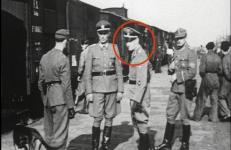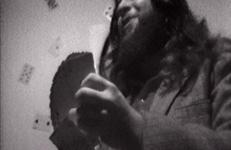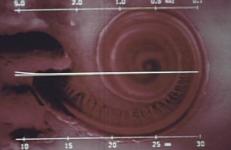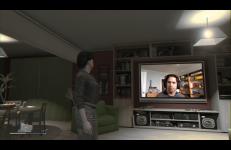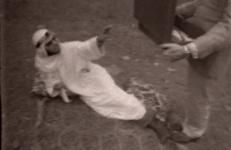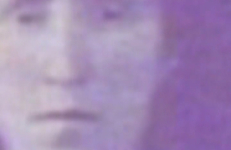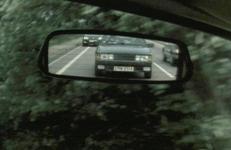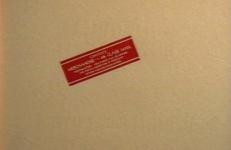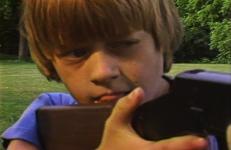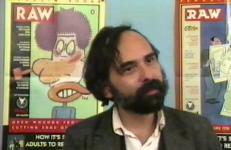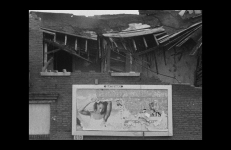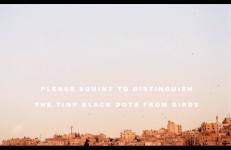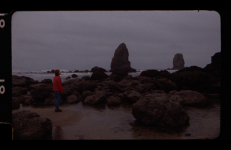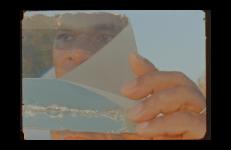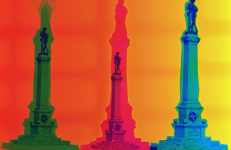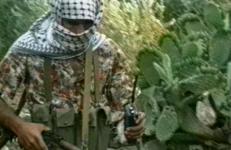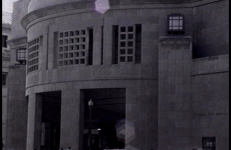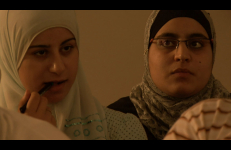Respite consists of silent black-and-white films shot at Westerbork, a Dutch refugee camp established in 1939 for Jews fleeing Germany. In 1942, after the occupation of Holland, its function was reversed by the Nazis and it became a 'transit camp.' In 1944, the camp commander commissioned a film, shot by a photographer, Rudolph Breslauer.
History
REVOLVER is a short film that weaves the perceptual phenomenon of pareidolia (a situation in which someone sees a pattern or image of something that does not exist) with an oral history narrated by a descendent of Exodusters. Nicodemus, Kansas (USA) was deemed a late 19th century refuge for Exodusters—Black people from the southern United States who fled violence and inequities following the Civil War. Guided by memory, history, and rumor of a Black utopia, REVOLVER proposes a psychogeographic history of place infused with visions and dreams.
Shot by Mary Curtis Ratclif at the O.K. Harris Gallery on Prince and Green Streets, New York, this tape focuses on performer “Ricky Jay” as he performs card tricks at his magic table for an enthusiastic audience.
"The human ear. A gatherer of energy. A gatherer of sound. RPMs and BPMs. Satellites go up to the sky."
In the video Satellite, Nelson Henricks combines found footage and techno beats to question western society's ongoing obsession with science, technology and the future. Juxtaposing images derived from old educational films with absurd, aphoristic slogans, Henricks offers up a witty, entertaining and provocative commentary of our need to make sense of everything, at any cost.
The Sea is History, made in the Dominican Republic and Haiti, is a free adaptation of the poem by Derek Walcott.
In this spoof program produced for Lanesville TV, the premise is that a “Sheik” has come to buy all the land in Lanesville. Videofreex member Carol Vontobel reports that the sheik (Bart Friedman), escorted by his real estate agent (Parry Teasdale) is approaching people in the community and asking to buy their homes. An unknown Lanesville local chauffeurs them around, and the Videofreex interview Mr. Benjamin, Mr. And Mrs. Kelly, Mr. Lloyd, Mr. and Mrs. Ginsburg, and others from the Tavern.
Sites Unseen is a 16mm film of the Jewish cemetery in Warsaw, a photograph of a great Aunt who died in Treblinka, and my late grandmother eating her morning cornflakes.
Music by Zeena Parkins
A nostalgic glazier shows off his knowledge and expounds his theories. Taking glassmaking processes and history as its central theme, Slow Glass explores ideas about memory, perception and change.
For the past 20 years Alexis Smith's mixed media work has explored primal American myths: the open road, the bad/good guy/gal, the quest for romance, and the search for paradise. This portrait of the artist explores the roots of her thought and work, and was produced in conjunction with her exhibition at the Whitney Museum of American Art, held in November 1991.
Smothering Dreams is a tough, scathing condemnation of war and our country's fascination with violence. Reeves draws on his own experience as a U.S. Marine in Vietnam in the 1960s, juxtaposing actual combat footage, staged war games, and child’s war play to make his message horrifyingly clear. This work is dedicated to the men of the 3rd Platoon Company A 1st Amtrac Battalion and the North Vietnamese soldiers who died on January 20, 1969 along the Cua Viet River.
Art Spiegelman was born and raised in New York, and began working as a cartoonist while still in High School. He attended the State University of New York in Binghamton, where he studied Philosophy. Spiegelman, who continued to work as a cartoonist, mainly in underground publications, throughout his schooling, has long been acknowledged as one of our era's foremost comic book artists. However, it was Maus, published in two volumes in 1986, that first brought his work to a mass audience. Maus tells the stories of a Jewish survivor of Nazi Germany and his son.
still/here is a meditation on the vast landscape of ruins and vacant lots that constitute the north side of St. Louis, an area populated almost exclusively by working class and working poor African Americans. Though it constructs a documentary record of blight and decay, still/here is a refusal of closure that dwells within the space of rupture and confronts the presence of a profound absence.
–– Christopher Harris
Camera, sound, edit: Christopher Harris
Additional camera: Joel Wanek
The Story of Milk and Honey is a short experimental video belonging to a larger project, which includes photographs, drawings and text, detailing an un-named individual’s failure to write a love story. Through voiceover narration that weaves together images, letters, and songs, a story of defeat transpires into a journey that explores how we collect and perceive information, understand facts, history, images, and sound and where the individual is to be found in the midst of the material.
Produced with the Fundación Marcelino Botín Grant for Visual Arts Fund.
Strike Anywhere is a video essay that takes as its point of departure Swedish "Match King" Ivar Kreuger, whose privatization of financial crisis management strategies bears a direct relation to late-20th Century policies implemented by the IMF and WTO. Between 1917 and 1932, Kreuger capitalized on shifts in global financial markets to control over 200 companies and establish matchstick monopolies in at least 34 countries. At the height of his success, Ivar Kreuger was worth approximately 30 million Swedish kronor (the equivalent of 100 billion USD today).
Strike Anywhere is a video essay that takes as its point of departure Swedish "Match King" Ivar Kreuger, whose privatization of financial crisis management strategies bears a direct relation to late-20th Century policies implemented by the IMF and WTO. Between 1917 and 1932, Kreuger capitalized on shifts in global financial markets to control over 200 companies and establish matchstick monopolies in at least 34 countries. At the height of his success, Ivar Kreuger was worth approximately 30 million Swedish kronor (the equivalent of 100 billion USD today).
A cinematic exploration of African American intellectual, social, and political life at University of Virginia during the 1970s. Starring Erin Stewart as Vivian Gordon, the director of UVA’s Black Studies program between 1975 and 1980, the film tells the story of African American women and men who through their public and private gestures sought to create a beloved community that thrived on intellectual exchange, self-critique, and human warmth.
A cinematic exploration of African American intellectual, social, and political life at University of Virginia during the 1970s. Starring Erin Stewart as Vivian Gordon, the director of UVA’s Black Studies program between 1975 and 1980, the film tells the story of African American women and men who through their public and private gestures sought to create a beloved community that thrived on intellectual exchange, self-critique, and human warmth.
Moments of resistance are collapsed and woven together; from documentation of the Indigenous led occupation of Alcatraz, to the reclamation of Cahokia and the repatriation of the ancestors, to one’s reflections on their body as they exist in the world today, these are gestures that meditate on the carceral inception and nature of the reservation system, and where sovereignty and belligerence intersect and diverge.
Sound by Courtney Asztalos
Music by Room Thirteen
Commissioned by the San Jose Museum of Art and the Institute of Arts and Sciences at UC Santa Cruz.
Sunstone tracks Fresnel lenses from their site of production to their exhibition in a museum of lighthouses and navigational devices. It also examines the diverse social contexts in which optics are implicated, contrasting the system of triangular trade that followed the first European arrivals in the ‘New World’ with the political potential seen in Op art in post-revolutionary Cuba.
Sunstone tracks Fresnel lenses from their site of production to their exhibition in a museum of lighthouses and navigational devices. It also examines the diverse social contexts in which optics are implicated, contrasting the system of triangular trade that followed the first European arrivals in the ‘New World’ with the political potential seen in Op art in post-revolutionary Cuba.
Statement
A last stand for the silent guardians of the old order. Take It Down is a filmic day of reckoning for the Old Confederate South. What is up must come down, like the Confederate soldier monuments standing in court house squares across the South. At long last, a grand inversion! Solarized film makes positives bleed into negatives. The South is renewed.
This film looks to North Carolina to describe the cultural fissure that runs through the South, a legacy of the Civil War. In the context of the divisive Trump presidency and the increasing visibility of white supremacist activism, these Confederate memorials have become sites of conflicting politics and historical narratives.
Historians agree that a majority of Confederate statues were erected as propaganda tools legitimizing racism in the era of Jim Crow laws. For example, “Silent Sam”, a statue depicted in the film, was erected on the quad of the University of North Carolina campus. In an act of civil disobedience in Fall 2018, students and protestors tore down the statue in a statement against white supremacist oppression.
An oblique, albeit powerful documentary that examines the current conditions, politics, and economics of South Lebanon. The tape focuses on the social, intellectual, and popular resistance to the Israeli occupation, as well as conceptions of "the land" and culture, and the imperiled identities of the Lebanese people. Simultaneously, the tape self-consciously engages in a critique of the documentary genre and its traditions.
An oblique, albeit powerful documentary that examines the current conditions, politics, and economics of South Lebanon. The tape focuses on the social, intellectual, and popular resistance to the Israeli occupation, as well as conceptions of "the land" and culture, and the imperiled identities of the Lebanese people. Simultaneously, the tape self-consciously engages in a critique of the documentary genre and its traditions.
Hermine Freed collaborates with James Ingo Freed to create a video essay/documentary that reflects upon memories of the holocaust during the design of a US memorial building. Hermine Freed provides video accompaniment that brings to life a lecture entitled The Architecture of the United States Holocaust Museum conducted by James Ingo Freed for the Architectural League at Rockefeller University, New York on November 11th 1993.
In 1959, Jean Rouch directed the film La Pyramide Humaine. Situated between fiction and documentary, Rouch’s work presents his attempts to initiate a debate between two groups of students from the Ivory Coast, a white group and a Black group. A precursor to cinéma vérité, this often forgotten film served as the starting point of The Four Chambered Heart.




